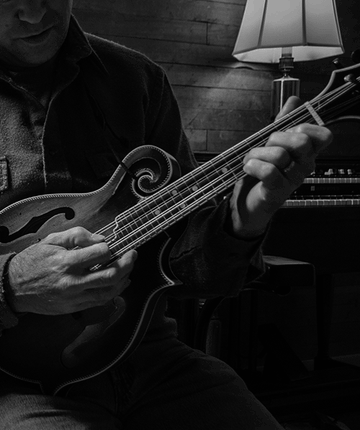Bass Guitar Scale Length - What you need to know

Scale length for bass guitars can be a rather grey area and ensuring that you choose the correct length strings for your bass can often prove troublesome. But fear not, we’re here to help guide you through the murky waters of bass scale lengths. Let’s get to it….
First things first, when it comes to understanding the length of strings we need for our bass, it’s important to know the difference between 3 important measurements. These terms can at times be misunderstood so let’s clarify these from the start by taking a look at each in turn.
- Scale Length
- Speaking Length
- Ball End to Nut
Scale Length
For all bass guitars, if you take a look at the specifications on the manufacturers website you’ll see a scale length quoted in inches e.g 32”, 34” etc. But what exactly is this and where are these measurements taken from?
Our good friend of the Strings Direct fold Chas Johnson describes scale length as “the distance that has been mathematically divided up to position the frets correctly so that the instrument plays in tune along its fingerboard.”
“The 12th fret is the centre of the scale length and so the scale length is measured by doubling the distance from the fingerboard side of the nut to the centre of the crown of the 12th fret. If you measure that distance and then add that same distance again from the crown of the 12th fret towards the bridge then that will tell you where the end of the scale length lies. For example if the distance from the nut to the centre of the 12th fret measures 17" then you double this to find the end of your 34" scale length.”
IMAGES


Above: As you can see the distance between the nut and the crown of the 12th fret is 17". If we then multiply this figure by 2 we get the scale length of our bass. In this case our P-Bass has a 34" scale length.
Not all basses have the same scale length and depending on the measurement you get by carrying out the exercise above, your bass will generally be categorised into one of four groups; short scale, medium scale, long scale or extra-long scale.
It should be noted that these measurements are a rough guide and whilst it’s handy to know roughly how our bass is categorised, it doesn’t really tell us the whole story when it comes to buying bass guitar strings. More on this a little later on.
Speaking Length
Speaking length is the distance between the take off points of the fingerboard side of the nut and the top of the bridge saddle for a given string, i.e. the length of the section of the string that is vibrating in the space between the nut and the bridge saddle and the part of the string that is said to be 'speaking'.
Chas explained further; “The speaking length will be slightly longer than the actual scale length because it is compensated. In order to set the intonation of a string so that it plays in tune at each fret along the fingerboard we need to ensure that the fretted note at the 12th fret is exactly the same pitch as the natural harmonic played over the 12th fret. To do this we have to compensate for the thickness of the string, its height above the fingerboard and the physics of how a string vibrates at each end nearest to its take off point.
In practice this means we have to move the saddle back slightly from the end of the scale length to get the intonation spot on. The saddle of the thinnest string will be positioned closest to the actual end of the scale length and the thickest string will have to be moved back the most from that point to intonate it.

Above: Speaking length is slightly longer than scale length. Our saddles are compensated and need to be moved back slightly in order for the bass to play in tune and intonate properly. As you can see our thickest string (at the top in the image) sits furthest back away from the scale length.
Again, whilst it’s good knowledge to know what 'Speaking Length' actually means, it doesn’t really help when it comes to sourcing the correct length of strings for our bass guitars. Instead, the next measurement we’re about to discuss is the one that we really need to know about…
Ball End to Nut
Here at Strings Direct, the measurement we insist on players taking is from the ball end of the string to the headstock side of the nut on their current set of strings (if your bass has a set on there) and this is how it’s done;


**PLEASE NOTE** If you have a bass where you cannot see the ball end i.e. a thru-body bass, you will have to measure your string once it has been removed. Before removing the string be sure to make a mark on the string with a permanent marker just behind the nut so you know where to measure up to. Then once you’ve unwound the string and taken it off the bass, you can measure from the ball end to the mark you made on the string.

A little tip if you need to do this, make sure you trim the top of the string before you pull it through the bridge. Trim after your mark but before the straggly bits that were previously around the machineheads…. if not removed these can easily get tangled up in the bridge and scratch the top of your bass if you’re not careful.
But why is this measurement so important?
The 'ball end to nut' distance you measure is the minimum length your strings need to be before any silk wrap or tapering should start. You’re aiming for the wound portion of the string to pass over the nut before the silk winding starts or the string starts to taper down.
If the silk starts before (or even in) the nut, it is a big no-no (see the image below). If this happens, the string simply won’t sound as it should, not to mention the strings may not even be long enough to reach or wrap around the posts of your machineheads.

You see, if we were to buy a set of strings based off our ‘scale length’ alone, you are potentially neglecting a few extra inches of string that crucially need to be accounted for. For instance, some tailpieces sit further back from the saddles than others, whilst some basses are strung through the back of the body. Having your strings anchored several inches further back like this inevitably means you’ll require a longer set than your scale length would initially indicate.
A great example of this is the Hofner Violin ‘Beatle’ Bass. The scale length of this iconic bass according to Hofner’s website is 30” putting it well and truly in the “short scale” category. Logically, you would assume that this bass would therefore need a ‘Short Scale’ set of strings. However, the strings are anchored approximately 3-4 inches further back from the saddles in its trapeze-style tailpiece. As a result, most “short scale” sets turn out to be too short and medium scale sets are usually the order of the day in this instance.

How do I know which sets will fit my bass?
It’s a great question. After all, nearly all bass sets are only labelled as short scale, medium scale, long scale and extra long scale with no measurements given. As we’ve seen, without being told the specific length of the strings, you are really taking a stab in the dark and hoping that a ‘long scale’ set of strings will be long enough to fit your ‘long scale’ bass. Unfortunately, there aren’t any firm “rules” on scale length that bass makers and string manufacturers stick to and as a result we often end up with conflicting interpretations of scale lengths where the length of one brand’s set will often be different to another brand’s.
So how do we overcome this issue?
Under the bass string section of our website, we categorise bass strings into ‘short scale’, ‘medium scale’ etc. depending on how each string brand labels them.
However, we’ve gone one further and we have made every effort to include the measurement from the ball end to the start of the silk winding (or taper) for all of the sets that we sell.
In fact, to make life easier we've created a handy filter that shows you all the bass strings that will fit your bass. Simply measure your bass up and select your measurement from the filter.... the website will then display all the sets that are suitable for your bass.
Where the information is available we also include the full length of the strings. If any sets have silk windings, we’ll include the colour and if there’s silk down by the ball end too.
A few extra things to note....
Bigger is better, right!?
“If bass players run the risk of selecting a set of strings that are ‘too short’, what’s stopping me buying a longer set and just trimming them down to the length that I need?
On face value, this is a logical question, and yes this can work for some people. That being said, string manufacturers will create their sets specifically for certain scale length basses and often the gauges they select are carefully chosen to help give optimum performance and playability.
It’s also worth noting that when a set of bass strings has been created solely for a specific scale length, often the thicker gauge strings will taper at a certain point so they can be threaded through the holes in the machineheads. This might sound crazy, but we do come across instances where some strings just won’t fit through the machineheads because they’re simply too thick.
Flatwound String Fans
Ideally, we only want the silk winding of our string to be wrapped around our machinehead, not the wound portion of the string. Therefore, we need the silk to start after the nut but before it reaches the post of our first machinehead.

This is really important if you are using flatwound bass strings. The windings on a flatwound string are wound seamlessly next to one another, and if you wind the wound portion of a flatwound string around the post, these windings can separate, exposing the inner core of the string which can make the strung vulnerable to breaking or unravelling.
No silk on the saddle
We’ve discussed in pretty great detail how we want to prevent the silk winding of our strings from starting before the nut of our bass.
However, we should mention that when strings have silk down at the ball end, it can be problematic for some basses with toploading bridges as there's a risk of the silk being too long and it becoming part of the speaking length of the string.

In the same way that we don’t want the silk to start before our top nut, we want to avoid the silk winding from running over our saddles too. If this does happen it can dampen the sound of the string and it won’t resonate and perform to its maximum potential.
Unfortunately, some brands can be inconsistent in how long the silk wrapping is so whilst we cannot be definitive with the length of silk at the ball end for any given set, we always mention if there is any silk winding down there.
Chas Johnson suggested a nice little tip around this topic; "If you find your strings do have the silk creeping over the saddles, depending on string gauge you might be able to thread an old ball end metal ring over the string to use as a spacer behind the back of the bridge and for Gibson style bass bridges there is always that 'mod-bar' device to stand all the ball ends back a bit from the back of the bridge."
Conclusion
As you can see the bass string landscape can prove baffling at times, but it really doesn't have to be that way. Knowing your 'ball end to nut' measurement will always serve you well when it comes to getting the correct set you need.
We do hope that we have been able to explain the concept of scale length and demystify the world of bass strings a bit more here.
As always, we’re here to answer any further questions you may have so feel free to send us an e-mail or comment below and we’ll be happy to help out wherever we can. Also if you have any suggestions for topics you’d like us to blog about, let us know and we’ll see what we can do. Thanks for reading and we’ll see you on the other side.






